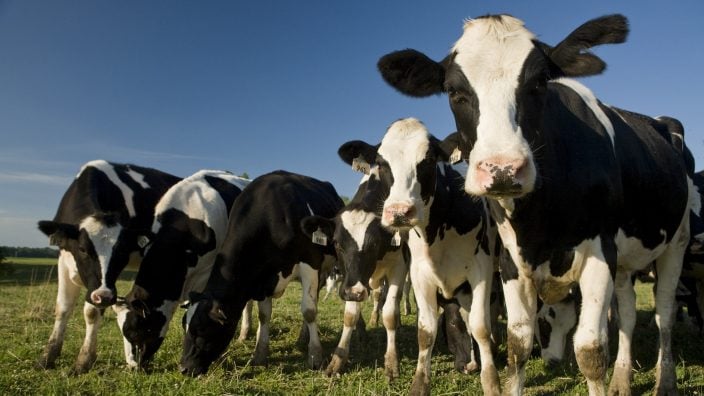Applications for Ohio Farm Bureau Health Plans now available
Members have three ways to apply: contacting a certified agent, calling 833-468-4280 or visiting ohiofarmbureauhealthplans.org.
Read More“Cows are the cause of global warming.”
Yes, this is a topic that keeps popping up. Cattle — dairy and beef — have a specialized digestive system with four stomachs that allows them to utilize a diet primarily composed of plant material. As a ruminant, they regurgitate and re-chew their food.
Cattle are able to produce large amounts of needed protein and energy for their bodies to produce milk or meat. And if you have ever spent any time around cows, you know that with this efficient digestive system comes methane production … aka burps, flatulence and manure.
There are almost 97 million cattle in the U.S., and worldwide, about 1.5 billion. Statistically, they release between 70 kilograms to 120 kilograms of methane per year. This is equivalent to 2,300 kilograms of carbon dioxide emissions each year.
That does seem like a lot when there is pressure to keep greenhouse emissions as low as possible. The first question that came to my mind is what percentage of the total greenhouse emissions is from cows?
Let’s look at the statistics in the U.S. The sources I found stated that 8% to 9% of the U.S. greenhouse gas emissions come from agriculture. Half of that is from all farm animals.
Energy is the biggest contributor at 84% and includes electric power, transportation, industrial, residential and commercial. Industrial process and waste each amounted to 4% of total emissions.
Energy is important to everyone. We are so reliant on it that we don’t think about it until it is not available. Transportation is in this category and is responsible for the biggest portion of emissions at 29%. Planes, trains, trucks and cars — without them, our country would come to a screeching halt. All the products and goods we buy wouldn’t get to stores and we wouldn’t be able to get to the stores to buy them.
So there is an allowance because we need transportation and the environmental cost is just a necessary part of doing business.
U.S. agriculture is equally important. At 8% total or less than 4% if you are considering just cows, agriculture is doing great. A very small percentage of the population provides the country with a reliable, healthy food supply.
So why does it seem like there is no allowance for agriculture. That farmers should feed us and have zero greenhouse emissions? Feeding you should qualify agriculture for an allowance.
What is your contribution to greenhouse emissions? You can go online and estimate your contribution using a carbon footprint calculator. I don’t know how accurate they are, but it will help you gain awareness.
This calculator takes into consideration lots of the things you do, where you live and even what you eat. Then computes what your impact is on the environment. You might be surprised by what your last vacation cost you.
I wish there was a carbon footprint calculator for agriculture. It would take into account the methane from animal agriculture, equipment usage, fertilizer and chemical usage. It would also take into account a lot of positive things that are being done to offset the negative:
Another factor to consider is the positive effect that photosynthesis from all of the planted crops. In an interesting article in the Smithsonian Magazine, Colin Schutz shares how NASA has been able to measure the level of photosynthesis across the United States. It can even be pictured by NASA because as the plant cells photosynthesize, part of the energy they produce is emitted as fluorescent light.
“At the peak of the growing season,” says NASA, “the Midwest U.S. corn belt is the most productive place on Earth — there’s more photosynthesis going on here than even the Amazon.”
Modern agriculture is often painted in a negative light, but the industry is doing its share to reduce greenhouse emissions. Through continued agricultural research and the implementation of new and improved practices, emissions will continue the downward trend.
Farmers, in my opinion, are the ultimate environmentalists. But, we all have a responsibility to be good stewards of the land and environment.
Submitted by Mary Smallsreed, a member of the Trumbull County Farm Bureau who grew up on a family dairy farm in northeast Ohio.
OFBF Mission: Working together for Ohio farmers to advance agriculture and strengthen our communities.


Members have three ways to apply: contacting a certified agent, calling 833-468-4280 or visiting ohiofarmbureauhealthplans.org.
Read More

Bill Patterson, Cy Prettyman and Adele Flynn will continue to serve as officers for Ohio Farm Bureau Federation.
Read More

Delegates discussed many topics impacting agriculture including farmland preservation, local foods, and succession planning.
Read More

Twenty-six farmers govern the state’s largest farm and food organization.
Read More

The 2025 recipients are Fred Cooke (posthumous) of Richland County, Marvin Dietsch of Williams County, Steven Knollman of Hamilton County and Michele Miller (posthumous) of Ottawa County.
Read More

Nathan and Jill Parriman grow seasonal crops, including Christmas trees, pumpkins and cut flowers, providing U-cut experiences that invite customers to engage directly with agriculture.
Read More

The 2025 Distinguished Service Award recipients are Craig Adams, Mike Townsley, and Kellogg Farms, Kurt Farms and Stateler Family Farms.
Read More

Ohio Farm Bureau Treasurer Adele Flynn participated in the meeting, representing Ohio farmers.
Read More

For Ohio and PJM region, the outlook is reassuring—ample reserves and strong planning should keep the power on.
Read More

The average price for a classic holiday feast for 10 in Ohio will cost $55.87.
Read More